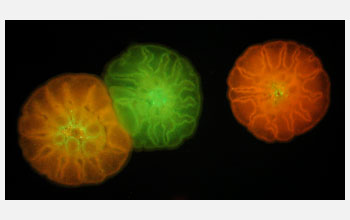Multimedia Gallery
Ecological Genomics of Reef Corals (Image 1)
Young sibling polyps of staghorn coral (Acropora millepora) one day after settlement. In a National Science Foundation-supported study, researchers found that the ability to fluoresce may influence whether or not the coral settle on the reef of their origin, or disperse and go elsewhere. [Image 1 of 6 related images. See Image 2.]
More about this Image
Staghorn coral (Acropora millepora) were the focus of an NSF-supported study by Misha Matz, an assistant professor of integrative biology at the University of Texas at Austin, and colleagues to address coral reef connectivity, genetics of physiology and life history traits, and their evolutionary modifications in response to ongoing climate change.
Results of the study found that young staghorn coral that fluoresce redder are less likely to settle and develop into coral polyps than their greener peers, a finding that may help scientists monitor how corals adapt to global warming because the less likely coral larvae are to settle, the more likely they will disperse from their reef of origin.
For the study, Matz and his team crossed different color morphs of staghorn coral, then exposed the offspring larvae to a settlement cue--ground-up calcareous red algae. They observed that larvae inheriting redder fluorescent color from their parents were less likely to settle and metamorphose into reef-building polyps than greener larva. How the coral respond to the settlement cue is strongly influenced by genetics, but it's not clear yet how that is linked with fluorescence.
"By simply looking at the color of a larval population, we may soon be able to say which larvae are going to be long-range dispersers and which will be short-range dispersers," says Matz.
"Under global warming, we expect a lot of evolution of this particular life history trait." Matz believes the long-range dispersers may become dominant because the corals will need to shift to cooler latitudes as water temperatures continue to rise.
While the genes that determine settlement and fluorescence are next to each other in the chromosome, scientists don't know if there is a correlation between the two or if this is completely random. It is also possible there could be a relation genetically between fluorescence and the ability of larvae to sense the proximity of a coral reef, making a more direct correlation between the two. Matz and his colleagues will be investigating these possibilities in the future.
But the question still remains: Why do corals fluoresce in such dramatic colors? Matz says, "Bright, multicolored fluorescence of reef-building corals is one of the most spectacular and least understood visual phenomena in the ocean, and we still have no idea what purpose it serves. But our discovery is a really good lead towards determining the function of fluorescence." [Research supported by NSF grant IOS 10-52461.] (Date of Image: October 2006)
Credit: Mikhail Matz, Joerg Wiedenmann
Images and other media in the National Science Foundation Multimedia Gallery are available for use in print and electronic material by NSF employees, members of the media, university staff, teachers and the general public. All media in the gallery are intended for personal, educational and nonprofit/non-commercial use only.
Images credited to the National Science Foundation, a federal agency, are in the public domain. The images were created by employees of the United States Government as part of their official duties or prepared by contractors as "works for hire" for NSF. You may freely use NSF-credited images and, at your discretion, credit NSF with a "Courtesy: National Science Foundation" notation.
Additional information about general usage can be found in Conditions.
Also Available:
Download the high-resolution JPG version of the image. (678 KB)
Use your mouse to right-click (Mac users may need to Ctrl-click) the link above and choose the option that will save the file or target to your computer.



